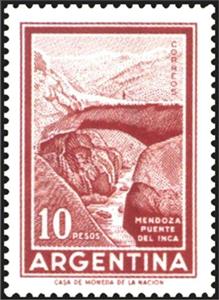Stamp: Inca Bridge, Mendoza (Argentina 1971)
Inca Bridge, Mendoza (Argentina 1971)
30 April (Argentina ) within release Personalities and landscapes goes into circulation Stamp Inca Bridge, Mendoza face value 10 Argentine peso ley
| Stamp Inca Bridge, Mendoza in catalogues | |
|---|---|
| Michel: | Mi: AR 1084Y |
| Stamp Number: | Sn: AR 889a |
| Gz (Cefiloza): | Gz: AR 1079 |
Stamp is vertical format.
Front & back sides fluorescentAlso in the issue Personalities and landscapes:
- Stamp - Catamarca - Cuesta de Zapata face value 3;
- Stamp - Catamarca - Cuesta de Zapata face value 3;
- Stamp - Catamarca - Cuesta de Zapata face value 3;
- Stamp - Catamarca - Cuesta de Zapata face value 3;
- Stamp - Inca Bridge, Mendoza face value 10;
Stamp Inca Bridge, Mendoza it reflects the thematic directions:
A bridge is a structure built to span physical obstacles without closing the way underneath such as a body of water, valley, or road, for the purpose of providing passage over the obstacle. There are many different designs that each serve a particular purpose and apply to different situations. Designs of bridges vary depending on the function of the bridge, the nature of the terrain where the bridge is constructed and anchored, the material used to make it, and the funds available to build it.
A landscape is the visible features of an area of land, its landforms and how they integrate with natural or man-made features. A landscape includes the physical elements of geophysically defined landforms such as (ice-capped) mountains, hills, water bodies such as rivers, lakes, ponds and the sea, living elements of land cover including indigenous vegetation, human elements including different forms of land use, buildings and structures, and transitory elements such as lighting and weather conditions. Combining both their physical origins and the cultural overlay of human presence, often created over millennia, landscapes reflect a living synthesis of people and place that is vital to local and national identity. The character of a landscape helps define the self-image of the people who inhabit it and a sense of place that differentiates one region from other regions. It is the dynamic backdrop to people’s lives. Landscape can be as varied as farmland, a landscape park, or wilderness. The earth has a vast range of landscapes, including the icy landscapes of polar regions, mountainous landscapes, vast arid desert landscapes, islands and coastal landscapes, densely forested or wooded landscapes including past boreal forests and tropical rainforests, and agricultural landscapes of temperate and tropical regions.
A river is a natural freshwater stream that flows on land or inside caves towards another body of water at a lower elevation, such as an ocean, lake, or another river. A river may run dry before reaching the end of its course if it runs out of water, or only flow during certain seasons. Rivers are regulated by the water cycle, the processes by which water moves around the Earth. Water first enters rivers through precipitation, whether from rainfall, the runoff of water down a slope, the melting of glaciers or snow, or seepage from aquifers beneath the surface of the Earth.
In geology, rock (or stone) is any naturally occurring solid mass or aggregate of minerals or mineraloid matter. It is categorized by the minerals included, its chemical composition, and the way in which it is formed. Rocks form the Earth's outer solid layer, the crust, and most of its interior, except for the liquid outer core and pockets of magma in the asthenosphere. The study of rocks involves multiple subdisciplines of geology, including petrology and mineralogy. It may be limited to rocks found on Earth, or it may include planetary geology that studies the rocks of other celestial objects.




